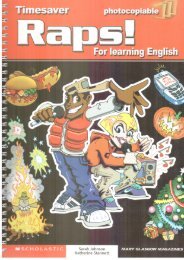English_Book_2-Teacher_300913
English_Book_2-Teacher_300913
English_Book_2-Teacher_300913
Create successful ePaper yourself
Turn your PDF publications into a flip-book with our unique Google optimized e-Paper software.
Grammar Focusand Discovering grammar (5 min.)The simple past of be (was/were)☞ See Grammar reference, page 103.• Tell students they will be learning how to makeaffirmative and negative statements using thesimple past of be verbs. Point these out in thegrammar chart. Say Let’s practice reading them. First,I’ll read aloud an affirmative statement. Then the wholeclass will read the negative statement. Go through theaffirmative statements, then switch roles with theclass. The class reads the affirmative and you readthe negative.• Have students work individually to complete theDiscovering grammar section. Check orally.Answer key1. be2. was, wasn’t3. were, weren’tPracticing grammar4 Practice (5 min.)• Ask students to complete the sentences with was,wasn’t, were, or weren’t.• Check by asking volunteers to read the completesentences aloud.Answer key1. was 2. were 3. was 4. was 5. were6. were 7. wasn’t 8. wasn’t 9. was 10. wereB.• PAIRS. Read the instructions and example aloud.Then elicit the nationality terms for each of thecountries listed.• Elicit the rest of the sentence about Albert Einstein.Then have pairs begin. Tell them to switch rolesafter the first round.• As students take turns making sentences, walkaround to monitor and help. Check orally.Answer key1. The Beatles were an <strong>English</strong> pop and rock group.2. Thomas Edison was an American inventor.3. Frida Kahlo and Diego Rivera were Mexican painters.4. Albert Einstein was a German scientist.5. Pierre and Marie Curie were French scientists.6. Mother Teresa was a Yugoslavian nun.Focus on multiple intelligences: this activityfocuses on visual intelligence.• You may want to prepare art materials for thisactivity, or you can have students do drawingsin pencil on notebook paper.• Divide the class into no more than seven groupsor pairs. For small classes, you may want tohave students work individually. Assign eachgroup one of the famous people in Exercise 5.Tell each group to make a drawing showingdifferent items belonging to or associated withthe famous person—for example, a cross, habit,food, and medical supplies for Mother Teresa.• As students work, walk around to elicit orteach them the <strong>English</strong> words for the itemsthey’ve drawn.• Have students present their drawings to theclass, pointing to and saying the name of eachitem they’ve drawn.TEACHER’S NOTES5 Practice (15 min.)A.• PAIRS. Read the instructions aloud. Go overthe list of names and occupations. Help studentspronounce the names. Check that studentsunderstand inventor, painters, scientist, and nun.• Have students work in pairs to label the photos.Elicit answers by pointing to each photo.Answer key(Clockwise from top left) Frida Kahlo and Diego Rivera (3),Mother Teresa (6), the Beatles (1), Pierre and Marie Curie (5),Thomas Edison (2), Albert Einstein (4)Have students complete Workbook Exercises 1–3and Grammar Builder Exercises 1–2.T54:57:37 PMPostcards_splitB_TE1_U06.indd T542/27/07 10:21:43 AM




